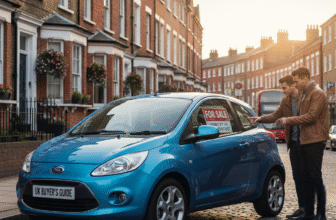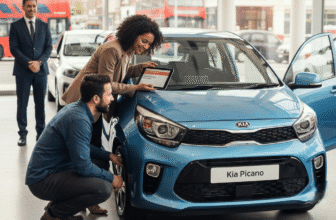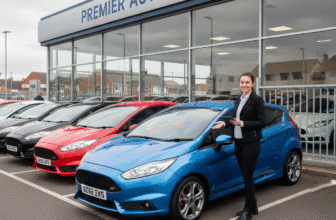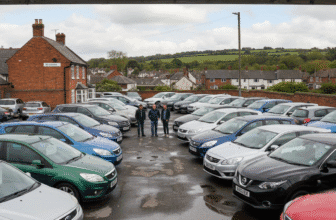
The Ultimate Guide to Finding the Perfect 125cc Motorbike for Sale in the UK
So, the bug has bitten. You’re picturing yourself filtering through city traffic with ease, embarking on weekend adventures along winding country roads, or simply enjoying the freedom and thrill that only two wheels can offer. You’ve started typing “125cc motorbike for sale” into search engines, and you’ve landed here. Welcome. You’re on the cusp of joining a fantastic community and unlocking a whole new way to travel. But before you part with your hard-earned cash, it’s crucial to navigate the exciting, yet sometimes confusing, world of 125cc motorcycles. This guide is your co-pilot, designed to walk you through everything you need to know to find the perfect ride for you right here in the UK.
Why a 125cc? The Perfect Gateway to Motorcycling
Let’s start with the basics. Why is the 125cc category the go-to choice for so many new riders? For a start, it’s the largest engine size you can legally ride on L-plates in the UK after completing your Compulsory Basic Training (CBT). This makes it the most accessible entry point into the world of proper motorbikes. But the appeal goes far beyond just licensing laws.
These machines are, for the most part, incredibly economical. In an age of soaring fuel prices, a 125cc bike that can easily achieve 100+ miles per gallon is a financial godsend. Road tax is minimal, and insurance, while variable, is significantly cheaper than for more powerful bikes. They are lightweight and nimble, making them an absolute dream for commuting through congested towns and cities. Parking woes become a thing of the past as you can slot them into spots cars can only dream of.

But don’t mistake them for mere commuter appliances. Modern 125s are packed with technology, style, and enough performance to be genuinely fun. They are the perfect learning tool, teaching you essential riding skills like throttle control, braking, and cornering in a manageable package. They are forgiving enough for a novice but engaging enough to keep a smile on your face long after the ‘L’ plates are gone.
Step One: Getting Legal – Understanding the CBT
Before you can even think about test riding a 125cc motorbike for sale, you need to get your paperwork in order. For the vast majority of new riders, this means getting a Compulsory Basic Training (CBT) certificate. It’s not a test you can fail; it’s a day-long course designed to ensure you can handle a bike safely on the road. The course is broken down into five elements:
- Element A: Introduction and eyesight check.
- Element B: Practical on-site training (learning the bike’s controls).
- Element C: Practical on-site riding (pulling away, braking, gear changes).
- Element D: Practical on-road training preparation (theory briefing).
- Element E: Practical on-road riding (a minimum of two hours on public roads with an instructor).
Once successfully completed, your CBT certificate allows you, as a learner, to ride a motorcycle or scooter up to 125cc. You must display L-plates (or D-plates in Wales), you cannot carry a pillion passenger, and you are not permitted to ride on motorways. Your CBT is valid for two years, giving you plenty of time to either enjoy riding on a CBT or progress to a full motorcycle licence.
Choosing Your Steed: What Flavour of 125cc Are You?
The term ‘125cc motorbike’ covers a surprisingly diverse range of machines. The right one for you depends on your personal style, what you’ll be using it for, and your budget. Let’s break down the main categories.
The Practical Scooter
For ultimate urban practicality, nothing beats a scooter. With ‘twist-and-go’ automatic transmission, they are incredibly easy to ride. They offer fantastic weather protection for your legs and often come with built-in under-seat storage, perfect for stashing your helmet or a bag of shopping. They are the commuter’s best friend.
- Top Picks: Honda PCX 125, Yamaha NMAX 125. These two are the titans of the scooter world, known for their build quality, reliability, and modern features like keyless ignition and stop-start technology.
The Stylish Naked Bike
When you close your eyes and picture a classic motorcycle, you’re probably thinking of a naked bike. Stripped back with an exposed engine and frame, they offer an upright, comfortable riding position. They are fantastic all-rounders, equally at home in the city as they are on a weekend blast. They look ‘like a proper bike’ and offer a more engaging ride than a scooter.
- Top Picks: Yamaha MT-125, Honda CB125R. The MT-125 is the hyper-naked king, with aggressive styling and premium components. The CB125R offers a beautiful ‘Neo Sports Café’ look and is renowned for being incredibly well-balanced and easy to ride.
The Racy Sports Bike
Dream of being the next MotoGP star? A 125cc sports bike is for you. With full fairings, a crouched-forward riding position, and styling taken directly from their larger-capacity siblings, these bikes look fast even when they’re standing still. They offer the sharpest handling and are a thrill to ride on twisty roads, though the aggressive ergonomics can be less comfortable for long journeys or city commuting.
- Top Picks: Yamaha YZF-R125, Aprilia RS 125. The R125 is essentially a mini-R7, offering an authentic sports bike experience. The Aprilia has a rich racing heritage and is often considered one of the best-handling bikes in the class.
The Laid-Back Cruiser
If a relaxed, low-slung riding style is more your vibe, a cruiser is the answer. These bikes are all about style and taking it easy. They typically have low seat heights, making them very accessible for shorter riders, and their engines are tuned for low-down torque rather than top-end speed. They might not be the fastest, but they have a cool factor that’s hard to beat.
- Top Picks: Lexmoto Michigan 125, Keeway K-Light 125. These brands offer fantastic value for money, bringing the classic American cruiser style to the learner-legal market.
New or Used? The Eternal Debate
This is one of the biggest decisions you’ll make. Do you go for a box-fresh bike with that new-vehicle smell, or a pre-loved machine with a more attractive price tag? Both have significant pros and cons.
Buying a New 125cc
The Pros:
- Peace of Mind: A new bike comes with a manufacturer’s warranty, typically for two years. If anything goes wrong, it’s covered.
- Reliability: It’s brand new. There’s no hidden history of drops, neglect, or abuse.
- Modern Tech: You get the latest features, such as ABS brakes (a legal requirement on new 125s), better fuel injection, and modern displays.
- Finance Options: Dealers offer attractive PCP and HP finance deals, making the initial cost more manageable.
The Cons:
- Cost: The initial purchase price is significantly higher than for a used equivalent.
- Depreciation: A new vehicle loses a chunk of its value the moment it leaves the showroom.
- The First Scratch Hurts: Dropping a brand new, pristine bike (and as a new rider, it might happen) is a heart-wrenching experience.
Buying a Used 125cc
The Pros:
- Lower Price: The biggest advantage. You can get a lot more bike for your money or simply save a significant amount.
- Less Depreciation: The initial big hit of depreciation has already been taken by the first owner.
- Less Worry: A small scratch or scuff on a used bike is much less painful than on a brand new one. It can make you a more relaxed learner.
The Cons:
- Risk: There’s no warranty. If the engine goes bang a week after you buy it, the repair bill is all yours.
- Hidden History: The bike could have been crashed, poorly maintained, or have underlying issues that aren’t immediately obvious.
- More Hassle: You need to do your homework and thoroughly inspect the bike, or pay a professional to do it for you.
Your Essential Used Bike Checklist: Don’t Get Caught Out
If you decide to go down the used route, you must inspect any potential purchase carefully. If you’re not mechanically minded, take a knowledgeable friend with you. Here’s a checklist to follow:
- Paperwork First: Always check the V5C logbook. Does the name and address match the seller’s? Do the VIN and engine numbers on the document match those on the bike itself? Check the MOT history online for free – it can reveal advisories and past failures that hint at recurring problems. Ask for service history.
- The Cold Start: Insist on seeing the engine started from cold. A warm engine can hide a multitude of sins, like difficulty starting. Place your hand near the exhaust downpipe (carefully!) to check it’s cold before they turn the key.
- Frame and Forks: Look for any signs of cracks, dents, or non-standard welds on the frame. Check the steering stops on the bottom yoke; if they are broken or battered, it’s a sign the bike has had a frontal impact. Check the fork seals for any weeping oil.
- Consumables: These tell you a lot about how the bike has been looked after. How much life is left in the tyres? Are the chain and sprockets rusty, overly tight, or with ‘hooked’ teeth? How thick are the brake pads? These items can be expensive to replace.
- Electrics: Test everything. Indicators, horn, high and low beam, brake lights (both front and rear levers), and the dashboard lights. Faulty electrics can be a nightmare to trace.
- Listen to the Engine: Once it’s running, listen for any rattles, knocks, or excessive smoke from the exhaust (a little white vapour on a cold day is normal, but blue smoke indicates burning oil).
- Test Ride: If the seller allows (and you’re insured), take it for a short ride. Does the clutch operate smoothly? Do the gears select cleanly? Does the bike pull in a straight line when you brake? Are there any strange vibrations?
Don’t Forget the Gear: All The Gear, All The Time (ATGATT)
Your budget for getting on the road shouldn’t just be for the bike itself. Investing in good quality safety gear is non-negotiable. It’s the only thing between you and the tarmac in an accident.
- Helmet: This is the only piece of gear required by law, but don’t just buy the cheapest one. Your head is priceless. Look for a helmet that fits snugly without pressure points. Check the government’s SHARP rating system to see how well it performed in safety tests.
- Jacket: A proper motorcycle jacket made of leather or tough textile will have built-in armour at the elbows, shoulders, and usually a back protector. It’s designed to resist abrasion and impact.
- Gloves: Your hands will instinctively go out in a fall. Motorcycle-specific gloves have reinforced palms and knuckle protection.
- Trousers: Regular jeans offer almost zero protection. Invest in proper riding jeans with aramid fibre linings (like Kevlar) and knee/hip armour, or go for full textile/leather trousers.
- Boots: Sturdy boots that cover the ankle are essential to protect against crushing and twisting injuries. Trainers are not an option.
Finding the right 125cc motorbike for sale is the start of an incredible journey. It’s a ticket to freedom, fun, and a new community. Take your time, do your research, be realistic about your needs, and invest in your own safety. Whether you choose a shiny new scooter or a battle-hardened used naked bike, the open road is waiting. Ride safe, and enjoy every single mile.







